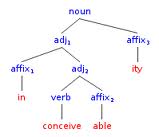What is Morphology?

Blogging, bromance, ridonkulous.
These are some newer words that have been added to English to describe new concepts, ideas, and current trends. Though they may seem spontaneous and unstructured at times, these and all words use set patterns of word formation, structure, and meaning, outlined in the study of morphology. All words are made up of small units called morphemes, some of which can be used independently (i.e. and, dog, fun), and some of which are not independently words but hold meaning (i.e. prefixes: un-, re-; suffixes: -ing, -ly). Morphemes are grouped into two main classes:
Here are some ways that new words can be formed, from most to least common:
Combining Processes:
Shortening Processes
Blending- joining two or more words, but one word is shortened in the process (i.e. Internet from interconnected network). Reduplication- repeating a morpheme to make new word (i.e. knock-knock or no-no). This is a lesser used process, but common in children’s developing language (mama, dada, booboo) and literature (rhyming pairs like Henny Penny, Humpty Dumpty). It is also more common in South Asian languages. |
in the classroom
Tips for Applying Morphology:
For more activities and lessons, go to the Florida Center for Reading Research’s website:
http://www.fcrr.org/. The search tool on the site helps teachers to find activities based on different morphological and literacy concepts and skills. | ||||||||||||||||||

